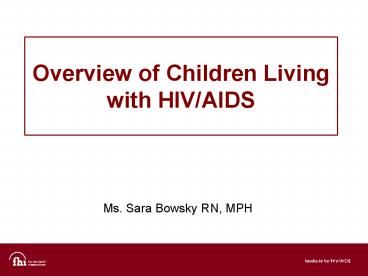Overview of Children Living with HIVAIDS PowerPoint PPT Presentation
1 / 17
Title: Overview of Children Living with HIVAIDS
1
Overview of Children Living with HIV/AIDS
- Ms. Sara Bowsky RN, MPH
2
Global HIV/AIDS EstimatesChildren under 15
years of age
- By The End of 2002
- 3.2 Million children were living with HIV/AIDS
- 87 in sub-Saharan Africa
- 610,000 children died from AIDS
- 90 of deaths in sub-Saharan Africa
- 800,000 new HIV infections in children
- 90 in sub-Saharan Africa
Source UNAIDS/WHO
3
Estimated impact of AIDS on under 5 child
mortality rates Selected African Countries 2010
Deaths per 1000 live births
with AIDS
250
without AIDS
200
150
100
50
0
Botswana
Kenya
Malawi
Tanzania
Zambia
Zimbabwe
Source U.S. Bureau of the Census
4
How do children become infected with HIV?
- 90 of HIV infection in children occurs through
mother to child transmission (pregnancy, labour
or breast feeding) - Other routes of transmission
- Blood transfusion
- Contaminated needles and syringes.
- Child sexual abuse
Source UNAIDS
5
The Impact of HIV/AIDS on Infant and Child
Survival
- Between 62-75 of children with HIV in developing
countries will not survive to their 5th birthday
(E. Pisani, 2001). - Rwanda, risk of death for a child with HIV is
45 and 62 by 2nd and 5th year of life. - 20 of children with HIV develop serious
illnesses within the 1st year of life (NAID,
1977). - Approximately half of the children showing signs
and symptoms in the first year of life die before
the age of three.
6
Why Are Children With HIV Dying So Young?
- Short survival time is a result of
- Late diagnosis or suspicion of HIV
- Lack of access to
- adequate health care
- case management of childhood illnesses
- prophylaxis treatment of opportunistic
infections - ART
- And prevalence of other endemic, acute or chronic
diseases
7
Response to Date
- Community Response
- Home Based Care
- Palliative Care
- Psychosocial Support
- Family Support
- Orphans and other Vulnerable Children
- IMCI/HIV
8
Response To Date Cont
- PMTCT Coverage 1 (0-37 range)
- 70 receive less than essential care package
- Without prevention, up to 10 of all newborns in
most affected countries could become infected
vertically. - 6 adults and only 1 of children receive PCP
Prophylaxis - 1 ART coverage for adults (range 1-18)
- ART coverage for children unknown
Source WHO 2000
9
Challenges
- Discrepancy between where child health and HIV
services are sought and where they are available. - The majority of children present to primary level
care - Overwhelming majority of children with HIV never
see an HIV trained practitioner. - Of those who do present to tertiary level care in
some southern and eastern Africa countries - Children with symptomatic HIV infection occupy
approximately 30 of hospital beds - Nearly 80 of these children are below 2 years
of age
10
Challenges cont
- Consumer choice
- Use of different service providers for different
child health/survival services increased
difficulty to provide integrated and
comprehensive services.
11
Source WHO
12
Comprehensive HIV/AIDS Care and Support
13
Needs of Children with HIV/AIDS Medical
Nursing
- Confidential Counseling and testing
- Initial diagnosis and treatment
- Routine care (esp. immunizations), health and
development - Nutrition
- Treatment of common childhood illnesses
- Access to prophylaxis and treatment of OIs and
other related illnesses - Access to ART
- Complementary home based care
- Palliative care (including pain management)
14
Needs of Children with HIV/AIDS Medical and
Nursing Sero-status Unknown
- Somewhat similar to that of children with known
HIV sero-status but - Option of VCT
- Counseling the parents
- Training of and identification by primary health
care workers in symptomatic diagnosis (IMCI/HIV)
and OI treatment
15
Needs of Children with HIV/AIDS Psychosocial
- Development of trust, self -worth and autonomy
- Ability to express fears and concerns
- Social integration with age groups and community
- Consistent, secure, and loving support from adult
care provider - Ability to carry out activities of daily living
with minimal discomfort
16
Needs of Children with HIV/AIDS continued
- Early Childhood Development (ECD)
- To continue school
- Caring and loving adult
- Stigma reduction
- Community care
- Family support interventions
- KEEP THEIR PARENTS ALIVE
17
The Bottom Line
- Some challenges are similar to those faced by
child health/survival programs - BUT in addition to strengthening integrated child
health services, including HIV/AIDS care and
support and ART, also need to - Mobilize/support communities
- Extend and strengthen social safety nets
- Strive towards family centered care

